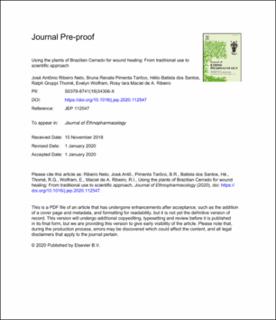Please use this identifier to cite or link to this item:
https://doi.org/10.21256/zhaw-19817| Publication type: | Article in scientific journal |
| Type of review: | Peer review (publication) |
| Title: | Using the plants of Brazilian Cerrado for wound healing : from traditional use to scientific approach |
| Authors: | Ribeiro Neto, José Antônio Pimenta Tarôco, Bruna Renata Batista dos Santos, Hélio Thomé, Ralph Gruppi Wolfram, Evelyn Maciel de A. Ribeiro, Rosy Iara |
| et. al: | No |
| DOI: | 10.1016/j.jep.2020.112547 10.21256/zhaw-19817 |
| Published in: | Journal of Ethnopharmacology |
| Volume(Issue): | 260 |
| Issue: | 112547 |
| Issue Date: | 1-Jan-2020 |
| Publisher / Ed. Institution: | Elsevier |
| ISSN: | 0378-8741 |
| Language: | English |
| Subjects: | Brazilian Cerrado; Medicinal plant; Traditional use; Wound healing |
| Subject (DDC): | 615: Pharmacology and therapeutics |
| Abstract: | Ethnopharmacological relevance The Brazilian Cerrado is a biome with a remarkable diversity of plant species, many of which are used mainly by local communities as a source of treatment to several pathologic processes, especially for the treatment of wounds. However, no systematic review exists focusing on the plants used in this respect and on the appropriate pharmacological investigations that substantiate the actions that are reported. This study revisits the traditional use of medicinal plants from the Brazilian Cerrado in the treatment of wounds and the pharmacological characteristics of the reported plant species. Methodology For the present article, previous studies on plants of the Brazilian Cerrado used for wound healing carried out between 1996 and 2018 were researched on various academic databases (PubMed, Elsevier, Springer, Lilacs, Google Escolar, and Scielo). Results A total of 33 studies were carried out on 29 plant species distributed into 18 families, mainly Fabaceae or Leguminosae (9), Bignoniaceae (2), Asteraceae (2), Euphorbiaceae (2). Considering the great diversity of Cerrado plants, only a small number of wound healing studies were carried out between 1996 and 2018. It was observed that there is a large gap between experimentation assay and traditional use. There are only few connections between the form of use by the population and the experiments conducted in the laboratory. We found that only about 12% of these studies considered to use the methodologies, or at least in parts, to obtain extracts such as those used in folk medicine. Approximately 37% of the experiments were performed using the bark as well as the same ratio for leaves, 6% using the fruits, and 9% using the seeds, roots or flowers. In several studies, there are reports of chemical constituents such as flavonoids and tannins, followed by steroid terpenes, saponins, and fatty acids, and alkaloids. However, approximately 35% of the studies did not supply information about compounds present in the preparation or the effect which could be attributed to these agents in respect to wound healing. Regarding treatment, most of the studies employed a topical treatment, though intraperitoneal and oral treatment were also described using either topical, oil-based formulations, but also gel- or saline-based formulations. Conclusions Although, there has been an increase in knowledge about the biological actions of plants from Cerrado biome, the scientific basis for the traditional use of these local medicinal plants in wound healing does not provide sufficient information on the efficacy of the treatment, the molecular mechanisms, or, in particular, the effective doses used and the drug interactions. Thus, focused research investigating these hypotheses from traditional knowledge is necessary to prove the evidence of the potential pharmacological action. |
| URI: | https://digitalcollection.zhaw.ch/handle/11475/19817 |
| Fulltext version: | Accepted version |
| License (according to publishing contract): | CC BY-NC-ND 4.0: Attribution - Non commercial - No derivatives 4.0 International |
| Restricted until: | 2021-01-31 |
| Departement: | Life Sciences and Facility Management |
| Organisational Unit: | Institute of Chemistry and Biotechnology (ICBT) |
| Appears in collections: | Publikationen Life Sciences und Facility Management |
Files in This Item:
| File | Description | Size | Format | |
|---|---|---|---|---|
| 2020Ribeiro Neto_Using the plants of Brazilian Cerrado_Journalof Ethnopharmacology.pdf | Accepted Version | 1.29 MB | Adobe PDF |  View/Open |
Show full item record
Ribeiro Neto, J. A., Pimenta Tarôco, B. R., Batista dos Santos, H., Thomé, R. G., Wolfram, E., & Maciel de A. Ribeiro, R. I. (2020). Using the plants of Brazilian Cerrado for wound healing : from traditional use to scientific approach. Journal of Ethnopharmacology, 260(112547). https://doi.org/10.1016/j.jep.2020.112547
Ribeiro Neto, J.A. et al. (2020) ‘Using the plants of Brazilian Cerrado for wound healing : from traditional use to scientific approach’, Journal of Ethnopharmacology, 260(112547). Available at: https://doi.org/10.1016/j.jep.2020.112547.
J. A. Ribeiro Neto, B. R. Pimenta Tarôco, H. Batista dos Santos, R. G. Thomé, E. Wolfram, and R. I. Maciel de A. Ribeiro, “Using the plants of Brazilian Cerrado for wound healing : from traditional use to scientific approach,” Journal of Ethnopharmacology, vol. 260, no. 112547, Jan. 2020, doi: 10.1016/j.jep.2020.112547.
RIBEIRO NETO, José Antônio, Bruna Renata PIMENTA TARÔCO, Hélio BATISTA DOS SANTOS, Ralph Gruppi THOMÉ, Evelyn WOLFRAM und Rosy Iara MACIEL DE A. RIBEIRO, 2020. Using the plants of Brazilian Cerrado for wound healing : from traditional use to scientific approach. Journal of Ethnopharmacology. 1 Januar 2020. Bd. 260, Nr. 112547. DOI 10.1016/j.jep.2020.112547
Ribeiro Neto, José Antônio, Bruna Renata Pimenta Tarôco, Hélio Batista dos Santos, Ralph Gruppi Thomé, Evelyn Wolfram, and Rosy Iara Maciel de A. Ribeiro. 2020. “Using the Plants of Brazilian Cerrado for Wound Healing : From Traditional Use to Scientific Approach.” Journal of Ethnopharmacology 260 (112547). https://doi.org/10.1016/j.jep.2020.112547.
Ribeiro Neto, José Antônio, et al. “Using the Plants of Brazilian Cerrado for Wound Healing : From Traditional Use to Scientific Approach.” Journal of Ethnopharmacology, vol. 260, no. 112547, Jan. 2020, https://doi.org/10.1016/j.jep.2020.112547.
Items in DSpace are protected by copyright, with all rights reserved, unless otherwise indicated.